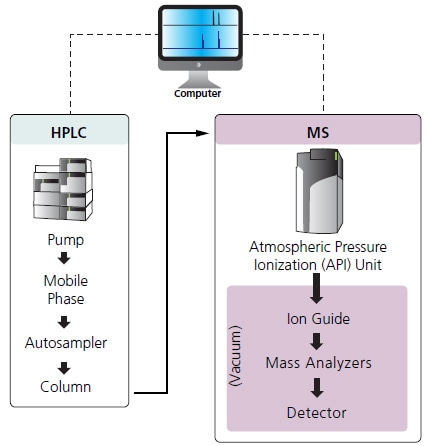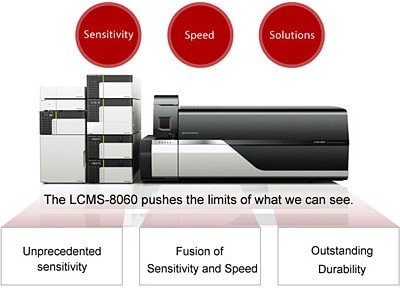Basic instrumentation of LCMS

Figure 5. Basic components of a LCMS system.
The basic components of a LC unit consist of:
- (1) Pump - delivers the mobile phase at a required flow rate,
- (2) Autosampler - injects the samples,
- (3) Column - for separation of sample,
- (4) Detector - for the analysis of the separated components in a sample.
For a LCMS system (Figure 5), the instrumentation comprises of:
- (1) a LC unit,
- (2) an interface between the LC and MS,
- (3) an ion source that ionizes samples (e.g. API unit),
- (4) an ion guide (an electrostatic lens that efficiently introduces the generated ions into the MS,
- (5) a mass analyzer unit that separates the ions based on their mass-to-charge (m/z),
- (6) a detector unit that detects the separated ions.
Examples of common MS detectors are electron multiplier and microchannel plate (MCP) where they operate by the secondary electron emission process. Together with the LC chromatogram, the quantity of ions that reach the detector is converted to a signal intensity and output to a computer. The ion guide, mass analyzer and detector are all housed in a vacuum in the MS. By holding it in a vacuum, the generated ions are able to be introduced, analyzed and detected in the MS with minimal collision and loss.
Besides the conventional LC which utilizes only one chromatography technique and column, there is the multi-dimensional chromatography which uses a combination of techniques (e.g. separation modes and/or columns) for separation. One such system is the two-dimensional LC (2D-LC) which can achieve higher selectivity not possible with conventional LC alone. There are various setups (e.g. online and offline) for multidimensional LC and it can be coupled to a MS to give a 2D-LCMS. The use of 2DLC in analyses can serve as a clean-up and pre-concentration step in a trap-and elute system. Another setup, a trap-free 2D-LCMS/ MS system, can allow the easy switch of involatile to compatible mobile phases for detection using MS.



